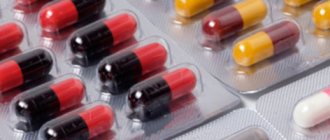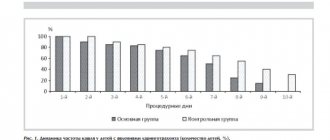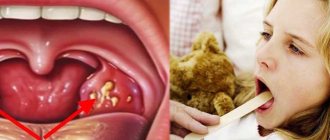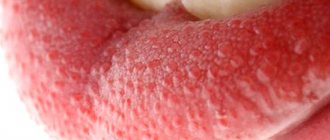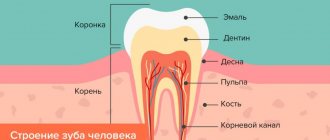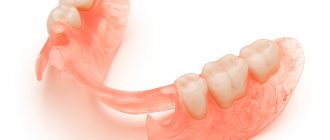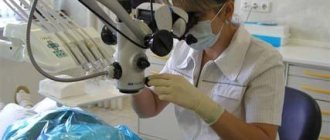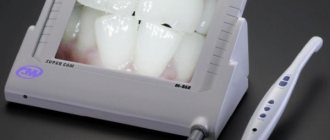Quincke's edema in children
- Symptoms of the disease
- How does Quincke's edema begin in a child?
- Causes
- First aid
- Treatment of Quincke's edema in children
Attacks most often occur in children with urticaria. Pediatricians associate swelling with hay fever, bronchial asthma, and atopic dermatitis.
Important! This is a dangerous condition, which in a quarter of cases provokes swelling of the larynx.
Quincke's edema occurs in newborns and older children. Its nature is most often allergic, but this phenomenon can be hereditary and also have no clear origin. Source: I.I. Balabolkin. Urticaria and angioedema in children // Pediatrics, 2009, v. 87, no. 2
The prognosis is usually favorable; it becomes poor with frequent relapses and associated swelling of the internal organs and larynx. The consequences may be anaphylactic shock, bronchospasm.
For prevention, in some cases vaccination is carried out. Its necessity is determined individually. Clinical recommendations for parents: provide the child with a low-allergen diet, take antihistamines at intervals recommended by the doctor, minimal or no contact with the allergen.
Causes of food allergies
There are several mechanisms for the development of allergies. But a significant proportion of cases are associated with type 1 hypersensitivity. It is explained by the release of immunoglobulin IgE and the activation of basophils. This reaction occurs in response to the entry into the digestive system of protein compounds recognized by immune cells.
Some predisposing factors are unique to children, others are also found in adults. Among the most common reasons are the following:
- Features of allergens in food. The reaction is most often provoked by antigens with high immunogenicity. They easily overcome the aggressive environment of the stomach. They are found in large quantities in whole milk, fish, eggs, cereals, strawberries, citrus fruits, and nuts.
- Hereditary predisposition. Food allergies are associated with hereditary characteristics of the body. They manifest themselves by increased reactivity, disruptions in the functioning of the immune system, as well as other mechanisms.
- Age-related features of the development of the digestive system. Children have high permeability of the stomach walls, and the acidity of gastric juice is lower than in adults. The composition of the microflora is also different. All this creates favorable conditions for the allergen to come into contact with immune cells.
The condition may be associated with the amount of food eaten and the characteristics of culinary processing. There are cases of so-called cross-allergy to pollen and household dust: some food products with similar compounds in their composition trigger an allergic reaction.
According to many researchers, the formation of allergies is facilitated by dietary violations during pregnancy, as well as early transfer of the child to artificial feeding. Gastrointestinal diseases, especially diseases of the liver, gallbladder, and biliary tract, also trigger and contribute to the exacerbation of allergies.
Symptoms of the disease
The reaction develops rapidly; signs of angioedema in children are swollen lips, neck, and face. The upper torso, hands, feet, and genital area are often affected. Quincke's edema is visible in the eyes of a child - the eyelids swell on one or both sides.
- When the tonsils are affected, the picture is similar to a sore throat.
- Edema of the larynx is indicated by a hoarse voice, difficulty breathing, a gusty cough, blue discoloration and then gradual paleness of the skin.
- Swelling that appears in one area may occur in another. This mainly applies to large-scale swelling.
- When the mouth and tongue swell, speech becomes difficult.
- If the process is localized in the gastrointestinal tract, the child may complain of tingling of the tongue, followed by diarrhea and vomiting, and sharp pain in the intestinal area.
- Rarely, swelling of the meninges occurs. With it, the child cannot fully tilt his head forward, complains of a headache, and behaves inhibited. Convulsions and vomiting may occur.
- If only the skin is affected, joint pain, fever may appear, and the child may lose consciousness.
The pathological condition can last from an hour to several days.
How does angioedema begin in a child?
Immediately after contact with the allergen, the listed symptoms increase sharply. This happens in a matter of minutes. Source: G. I. Smirnova. Urticaria and Quincke's edema // Allergic diseases in children. Ed. M.Ya. Studenikina, I.I. Balabolkina. M.: Medicine, 1998: 279-287 If you press on the swollen area, the child will not experience pain, but you will feel a dense swelling, on which, after pressing, there will be no characteristic depression.
Quincke's edema is not fatal
Angioedema, Quincke's edema, anaphylactic shock... We know that all these are acute conditions associated with allergies, but most of us do not particularly understand the difference between them, and do not understand how to help ourselves or another person in such a situation. We asked a professional to clarify
Our questions are answered by
Doctor of Medical Sciences, Professor of the Department of Childhood Diseases of the Children's Children's Diseases named after N.F.
Filatov Sechenov University, allergist-immunologist of the highest category Asya Kudryavtseva. – Asya Valerievna, let’s start with Quincke’s edema, which is especially often discussed on social networks. How dangerous is this condition?
– Quincke's edema is an outdated name. Now it is called angioedema.
Angioedema and urticaria are two parallel ongoing stories. These are conditions associated with the release of histamine from mast cells.
Histamine
An organic compound with a number of functions, including being a mediator of immediate allergic reactions. Under normal conditions, histamine is found in the body predominantly in a bound, inactive state. During various pathological processes, as well as when certain chemicals enter the body, the amount of free histamine increases.
- How does this happen?
– In case of allergies, angioedema can be caused by taking medications, food products, in young children after eating milk or eggs, in older ones - fish, seafood, nuts or peanuts. Swelling can occur when bitten by stinging insects.
Immunoglobulins E are antibodies directed against a protein we call an allergen and are associated with immediate, dangerous allergic reactions. Allergens dock with immunoglobulin E, like spaceships dock with a station, and together they attach to mast cells, which release histamine in response. Histamine, in turn, enters the body tissues, causing symptoms such as redness, swelling and itching.
If the release of histamine occurs on the skin of the arms, abdomen and back, blisters will appear in these places, such as we see when a mosquito bites. With urticaria, the blisters can be small in diameter, but sometimes they increase in size and even merge.
Angioedema, unlike urticaria, is the release of histamine in that part of the skin where it is well supplied with blood and is prone to swelling. If this occurs in the area of the eyelids, lips, hands or feet, the swelling in a person looks threatening, and it often changes his appearance. Despite the fact that the symptoms of urticaria and angioedema are not very similar, the essence of the events that occur is the same.
– Doesn’t angioedema affect the larynx? After all, this is the scenario that people fear most.
– It seems to us that with swelling of the eyelids and lips, a similar process occurs in the larynx. In fact, this is not true. Laryngeal edema is an extremely rare condition.
I have encountered the following misunderstanding: some people believe that angioedema is the lips and eyes, but Quincke's edema is the swelling of the tongue and larynx. In fact, angioedema and angioedema are different names for the same condition.
Just Quincke's edema, as I already said, is an old terminology that has existed since the end of the 19th century, when the German physician Heinrich Quincke first described it.
But now it has fallen out of use in professional language. The fact is that when we see blisters on the stomach, it does not particularly frighten us, but when a child or an adult’s eyelids are so swollen that it is difficult to open their eyes, the lips have greatly increased in size, there is a feeling that something completely terrible is happening, and we begin to fear serious consequences.
I have discussed angioedema many times with resuscitators, asking them how often angioedema actually leads to respiratory arrest. They answer that they have not encountered fatal outcomes of angioedema when it comes to allergic conditions associated with histamine.
– Where does the fear of death from suffocation due to angioedema come from?
– There is a very dangerous disease - hereditary angioedema (HAE), which, indeed, can lead to fatal consequences, but, despite its external resemblance to ordinary angioedema, it is a completely different independent disease, and an orphan (very rare). It is not caused by an allergy.
If with ordinary angioedema antihistamines help well, then with HAE the lips and tongue may swell, greatly increasing in size, but no antiallergic drugs will help here. The leading role here belongs not to histamine, but to bradykinin, a completely different mediator.
This condition also occurs suddenly, but rarely in children, more often in adults, and it can be provoked by a sudden strong experience or stress.
Not only antihistamines will not relieve such angioedema, but also hormonal drugs that are used for severe allergic reactions; only a blood plasma transfusion or the introduction of special medications that are not available over the counter will help.
Doctors know how to differentiate between these two conditions, but lay people are usually unaware of the difference between the two diseases, and are worried that they may suddenly have an attack that will lead to respiratory arrest.
It turns out that fears of a fatal outcome are true only in relation to hereditary angioedema, in which the tongue can swell to such an extent that suffocation occurs. I repeat once again: this condition is very rare, there are only a few such patients.
As a rule, before this kind of attack occurs, the patient already knows about his illness. It is possible that he has already been on the operating table due to sudden abdominal pain characteristic of appendicitis. They begin to operate on him for appendicitis, but they find swollen mesentery and intestines there, because swelling in such patients can occur in any part of the body.
Simple angioedema can be treated with all the familiar antihistamines and hormones.
– Can allergic angioedema suddenly appear in adulthood?
– Yes, this happens, but unlike HAE, it is precisely an allergic reaction. In adults it is most often a drug allergy, in children it is a food allergy. These conditions, as I have already mentioned, depend on the appearance of class E immunoglobulins in the blood, the level of which can be looked at in the blood after an attack and the allergy can be confirmed.
This situation is not fatal, and the person can be helped.
Angioedema occurs within a few minutes to two hours after contact with the allergen. With an allergy to animals, it can develop in a child, for example, if his hands are licked by a dog as a reaction to the animal’s saliva. Or, for example, if a child stroked an animal and then rubbed his eyes with the same hand. There will also be swelling there. Then we will talk about allergens that are in the fur of a cat or dog.
When plants bloom, pollen can get into your eyes and cause swelling of the eyelids. This year, the alder bloomed for a very long time and intensively, and we, allergists, observed angioedema of the eyes quite often. This is always an acute immune-dependent reaction, that is, a manifestation of pollen allergy (hay fever).
– What would you recommend as first aid?
– Absolutely all people prone to developing allergies should have some kind of antihistamine in their home or travel medicine cabinet, since, indeed, the onset of allergies can happen suddenly.
A child or adult with angioedema must be given a drug that blocks the effect of histamine on tissue. I would like to note that often there is no high urgency in taking a medicine, and if suddenly such a drug is not at hand, you can have time to get to the nearest pharmacy and buy it. They are freely available.
In the acute phase of the disease, absolutely any antihistamines can be used, including those that cause a sedative effect (suprastin or tavegil). These drugs are absorbed already in the oral cavity, act as quickly as possible and relieve swelling well.
It must be remembered that after taking such a drug, a person should not drive. Most likely, the doctor will prescribe further treatment for him, and then he will need to use a more modern medicine (Claritin, Erius, Zyrtec or Xyzal), which is taken once a day and does not have a sleeping effect.
These drugs retain high concentrations in the blood well, so their effect, unlike first-generation drugs, is quite long-lasting. They are not addictive, so you can take them for a long time.
– And there is also anaphylaxis. Should I be afraid of her?
– Anaphylaxis is a lesion during the development of an allergy of at least two systems at once. In the vast majority of cases, this happens to a person who has been suffering from allergies for some time. This is a condition that affects more than just the skin. Other organs are involved, and we observe, for example, angioedema and difficulty breathing, angioedema and diarrhea, hives and vomiting, and so on.
In itself, anaphylaxis without shock is not a life-threatening condition, but it is anaphylactic shock, which is quite rare, that leads to the death of the patient.
Due to increased anxiety these days, many people mistakenly believe that anaphylactic shock can suddenly happen to literally anyone, which is absolutely wrong.
This is a very rare occurrence even in people who suffer from allergies, let alone in the healthy population.
It happens like this.
A child or adult ate peanuts for the first time and his mouth itched. The second time, swelling of the eyes occurred. The third time, not only did my eyes swell, but it became difficult to breathe. When swelling of the eyes and suffocation occurs, this is already an anaphylactic reaction. It can be either not very severe or severe, when loss of consciousness occurs and the person may die.
A reaction is considered mild when there is no sharp decrease in pressure and changes in the cardiovascular system. Doctors treat this condition with a fast-acting drug called epinephrine.
In everyday life in developed countries of the world, auto-injectors are used - these are syringes in the form of automatic pens so that the patient, feeling the approach of anaphylaxis, can quickly inject himself (or a sick child) into the thigh directly through clothing. This should be done when even mild anaphylaxis occurs, without waiting for shock.
Usually a person knows how his allergies develop. It is clear to him from the symptoms that he ate something wrong, for example, there were trace amounts of peanuts in chocolate without nuts, which is an allergen for this patient.
Epipen - the so-called pen filled with adrenaline, can be used in absolutely any situation, not necessarily at home or in a hospital. It is recommended that each patient always have two of these pens with him.
In Russia, Epipen and Epipen Junior (for children) are registered, but, unfortunately, they are not sold in pharmacies.
Anyone who is at risk of developing anaphylaxis needs to be trained in how to give injections with a regular syringe at home or with an auto-injector while an ambulance is being called for the patient. Administering adrenaline by regular injection is not a very good treatment option, because it is not so easy to calculate and inject the required dose of adrenaline.
Now such patients and parents of children prone to anaphylaxis are uniting among themselves to achieve centralized purchase of Epipen from the state so that it can be purchased at a pharmacy with a doctor’s prescription. However, many of them buy EpiPen online, which is not prohibited by law.
To teach how to use an auto-injector, the manufacturing company even produces special training pens. The patient should be trained not to worry about how he will cope with the injection in an acute situation. They also explain to him what sensations he should experience during autoinjection.
It must be borne in mind that even after the administration of Epipen, it is necessary to call an ambulance, and doctors must monitor the condition of the child or adult after an attack of anaphylaxis.
Often, parents of children at risk of developing anaphylaxis themselves use the drug prednisolone. In such cases, we doctors instruct them in detail.
I would like to emphasize once again: anaphylaxis is a rare phenomenon, and anaphylactic shock is even rarer. I observe a level of anxiety among people about these phenomena that is completely out of proportion to the scale of the problem.
For example, many people believe that dental anesthesia drugs are extremely dangerous, and literally each of us has a chance of not getting out of the chair after dental treatment.
There are studies, however, that demonstrate that the risk of anaphylaxis due to local anesthetics is extremely low. It happens that a person attributes the symptoms that he experiences after such an injection to anaphylaxis, but in fact he had them as a result of a panic attack.
I write a blog, “Life Without Allergies,” on the Internet. There I provide scientific data, for example, the following: the number of deaths from anaphylaxis is from 0.35 to 1.06 episodes per million inhabitants per year, while this figure has not changed over the past 10-15 years. Moreover, death from anaphylaxis in the general European population is much less common than accidental death.
Cases of death from anaphylaxis are often described in the media, which is why they cause such a strong reaction in us. Now people are more worried about their health than usual, but I advise everyone to approach the problem wisely and not be afraid of an event whose risk for the vast majority of people is negligible.
Link to publication: miloserdie.ru
Causes
A complex of immunological reactions is most often caused by:
- Food;
- medicines;
- volatile allergens (pollen, chemicals, etc.);
- insect bites.
The disease may be non-allergic in nature. In this case, in addition to allergens, it is caused by: stress, infectious diseases, external factors (for example, hypothermia), intoxication of the body. Source: A. V. Lyapunov. Urticaria and Quincke's edema in children // Children's allergology. Ed. A.A. Baranova, I.I. Balabolkina. M.: GeotarMedia, 2006; 486-497.
Medicine also knows quite a lot of cases where the reason for such a reaction of the body has not been established.
2. Reasons
The variety of factors that can cause laryngeal edema are usually divided into large groups:
- hypersensitivity reactions (allergy, anaphylactic shock, etc.);
- injuries, including mechanical, chemical, thermal, radiation;
- acute infectious diseases of the ENT organs (especially in children);
- acute and chronic infectious and inflammatory processes in the laryngopharynx and adjacent structures;
- cardiovascular diseases;
- oncological diseases;
- renal failure with impaired fluid excretion.
Factors that increase the risk of developing laryngeal edema due to the above reasons include hypovitaminosis and exhaustion, diabetes mellitus, weakened immunity, and smoking.
Visit our Otolaryngology (ENT) page
First aid
call an ambulance immediately . Doctors may decide on emergency hospitalization if the patient has difficulty breathing, a swollen tongue, or symptoms indicating intestinal damage.
What to do before the doctors arrive?
First aid, which should be provided at the first symptoms of angioedema in children, involves clearing the airways, checking breathing intensity, heart rate, and blood pressure. Sometimes it is necessary to perform cardiopulmonary resuscitation, so after the first case, parents are recommended to take first aid courses. At the final stage, medications should be administered to the child.
First aid equipment includes:
- glucocorticosteroids (“Prednisolone”, “Dexamethasone”);
- antihistamines;
- adrenalin.
Sequence of administration: adrenaline, then glucocorticosteroid, then antihistamine. If the reaction is moderate, then adrenaline is excluded.
| Adrenalin | It is injected intramuscularly into the thigh (middle third outside) at the rate of 0.01 mg for each kg of the child’s weight. If there is no effect, then the injections are repeated every 15 minutes. |
| Glucocorticosteroids | Injected intramuscularly into the buttock or intravenously. You can pour the medicine from the ampoule under the tongue - this way the effect will come faster. The dosage of Prednisolone is from 60 to 150 mg, Dexamethasone is from 8 to 32 mg. |
| Antihistamine | Intramuscular injection is preferable. It is possible to take a pill, but the effect will come later. The dosage depends on the medicine. For example, “Loratadine” – 10 mg, “Cetrizine” – 20 mg. |
Important! In case of swelling of the larynx, a tracheostomy is performed urgently.
Is it possible to quickly relieve allergic edema using topical agents?
Various external ointments containing hormones, mainly corticosteroids, are intended for this purpose. They are used as prescribed by a doctor, rubbing into the swollen area 2-3 times a day.
In addition, skin and nasal sprays and drops with a decongestant effect have recently appeared. To choose the right remedy and optimal dosage form, it is better to consult a doctor.
To quickly relieve allergic edema, there are many effective folk recipes. So, a mask made from fermented milk products (kefir, sour cream) helps to remove swelling from the face. It should be applied to the face for 15-20 minutes and then rinsed off with cool water. No less effective is applying an ice heating pad or directly massaging ice cubes made from freshly frozen black or green tea. Ice cubes are an excellent remedy for removing swelling from the lips. If your eyelids are swollen, an old cosmetologist - a cucumber - will come to the rescue. It is cut into rings, which are applied to the eyelids for 10-15 minutes.
Treatment of angioedema in children
- stopping contact with the allergen;
- removal of the allergen from the body (sorbents, drinking plenty of fluids);
- the use of antihistamines, glucocorticosteroids, diuretics and other drugs, depending on individual indications.
The treatment plan may vary and include other interventions and complex drug therapy. It depends on the type of disease, the number of relapses and other factors. It is necessary to obtain specialist advice.
Sources:
- I.I. Balabolkin. Urticaria and angioedema in children // Pediatrics, 2009, v. 87, no. 2.
- G. I. Smirnova. Urticaria and Quincke's edema // Allergic diseases in children. Ed. M.Ya. Studenikina, I.I. Balabolkina. M.: Medicine, 1998: 279-287.
- A. V. Lyapunov. Urticaria and Quincke's edema in children // Children's allergology. Ed. A.A. Baranova, I.I. Balabolkina. M.: GeotarMedia, 2006; 486-497.
Grek Elena Anatolyevna Clinic
Author of the article
Grek Elena Anatolyevna
Doctor of the highest qualification category
Specialty: allergist
Experience: 24 years
The information in this article is provided for reference purposes and does not replace advice from a qualified professional. Don't self-medicate! At the first signs of illness, you should consult a doctor.
Types of edema.
There are several types of Quincke's edema.
Angioedema can be hereditary or acquired. Hereditary angioedema is a rare genetic disease that was first described at the end of the 19th century and is characterized by recurrent edema. If a mother or father has this diagnosis, the probability that their child will be born with the same diagnosis is 50%. With timely prevention and proper treatment, the patient’s attacks rarely occur, and the patient lives quite well with this diagnosis. Cases of acquired disease are quite small, and are most often observed in elderly patients.
Depending on the cause that caused Quincke's edema, allergic, non-allergic and idiopathic edema are distinguished when the cause of the condition could not be determined.
Prices
| Name of service (price list incomplete) | Price |
| Appointment (examination, consultation) with an allergist-immunologist, primary, therapeutic and diagnostic, outpatient | 1750 rub. |
| Prescription of treatment regimen (for up to 1 month) | 1800 rub. |
| Consultation (interpretation) with analyzes from third parties | 2250 rub. |
| Consultation with a candidate of medical sciences | 2500 rub. |
| Allergen-specific immunotherapy (ASIT) - maintenance course (excluding the cost of the drug) | 8100 rub. |
Diagnosis and causes of drug allergies
Diagnosis begins with identifying the specific drug that provokes the development of allergies. In some cases this is obvious and a history may be sufficient. Sometimes you will need to conduct a series of allergy tests. In any case, diagnosis does not take much time.
To help the doctor make a diagnosis, it is worth preparing answers to the following questions: what medications the patient took before developing allergies, whether there have been similar episodes before, which medications the patient has been taking for a long time, and which ones were recently prescribed. It is important to accurately describe symptoms and record their duration.
The causes of drug allergies are simple and clear - the development of a pathological response to a substance that is part of the medication.

